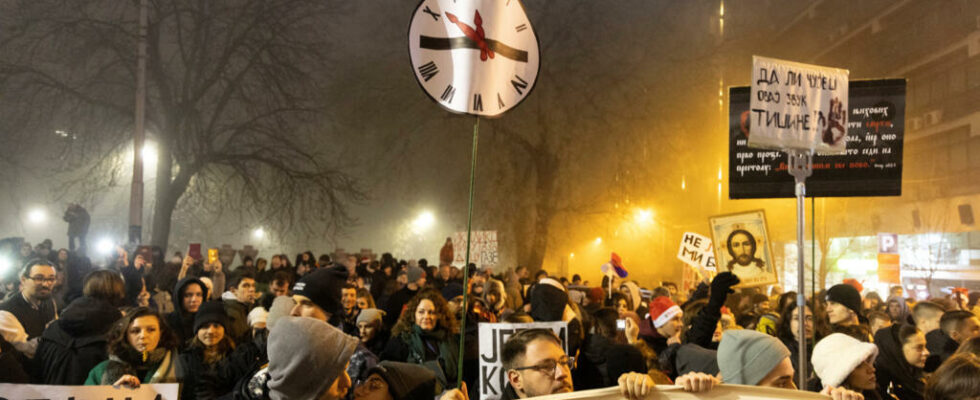Aleksandar Vučić’s regime is facing a wave of protests that has continued to grow since the disaster at the Novi Sad station on November 1, which cost the lives of fifteen people.
5 mins
Since mid-November, throughout the Serbiamore than 60 faculties are occupied day and night by their students, supported by their teachers, but also by thousands of anonymous citizens who come every day to bring them food. On January 31, tens of thousands of Serbs celebrated in the streets, as they had done on January 31, 1996, when a wind of revolt was sweeping the country.
That year, the regime of Slobodan Milošević wanted to annul the result of the municipal elections won by the opposition in all the major cities of the country, including Belgrade, provoking a wave of revolt that shook the entire Serbian society, starting by the students. After two months of daily demonstrations, despite the repression and the freezing cold which had fallen on the Balkans, the government finally had to give in. This time, it was the collapse of the awning of the Novi Sad station on November 1, killing fifteen people, which ignited the situation.
This station, restored by a Chinese company, had been inaugurated with great fanfare a few months earlier by the president Aleksandar Vučić and Hungarian Prime Minister Viktor Orbán. Novi Sad is in fact a stage on the future high-speed line which will link Belgrade to Budapest and which Chinese companies are also building. In the days following the tragedy, Novi Sad experienced the largest demonstrations in its history, while the movement spread throughout the country.
“Your hands are bloody”
Every day, throughout Serbia, thousands of people stop all activity at 11:52 a.m. – the time of the disaster – respecting fifteen minutes of silence, in honor of the fifteen victims, blocking streets or intersections. These gatherings were often attacked by “unknown people”, sometimes hooded, always very organized, in the complicit indifference of the police. This violent repression did little more than spread the protest. “It was seeing my classmates at the Faculty of Dramatic Arts getting beaten up that made me decide to join the movement”explains Dejan, an anthropology student in Belgrade.
“Your hands are bloody”launch protesters against the regime of Aleksandar Vučić, accused of massive corruption. Everywhere, workshops are being improvised: we coat our palms with red paint before applying the mark on posters or banners. This red palm has become the equivalent of the black clenched fist of Otpor movementthe one who ousted Milošević from power in October 2000. The students rule out any return to normal as long as their demands are not met: publication of all documentation on the reconstruction of the Novi Sad station, lifting of all accusations made against the arrested demonstrators, indictment of the people who attacked the students, resignation of the Prime Minister.
Serbia on the verge of a general strike?
The government has long treated the movement with contempt. Prime Minister Miloš Vučević denounced an attempt to “political destabilization”, hatched by “foreign forces hostile to Serbia”whose identity he did not specify. The European Union, moreover, remains surprisingly silent while Serbia, politically close to Moscow, is still a candidate for integration.
The Serbian regime, however, has reason to worry. The country is now on the verge of a general strike, explains Đorđe Vukadinović, interviewed by the independent channel N1. According to this analyst and former MP, these are “all of Aleksandar Vučić’s picks” which are now contested. And the regime would like at all costs to avoid the scenario involving the formation of a technical government responsible for organizing elections, which would finally take place without pressure or vote buying, “even if it means choosing confrontation”.
“I don’t know how long this will last, but it is undoubtedly the beginning of the end of the Vučić regime”he continues. In fact, the social base on which the Serbian Progressive Party (SNS), which has ruled unchallenged in Serbia since 2012, relies is faltering. A ” convergences of struggles » unprecedented is being done with other movements, such as those opposing the exploitation of lithium.
Divided and discredited political opposition
The exploitation of Serbian reserves was suspended three years ago, following the “ecological uprising” which engulfed the entire country in the fall of 2021. This summer, the Serbian Parliament gave the green light to exploitation ore, while German Chancellor Olaf Scholz came to Belgrade to witness the signing of a “strategic partnership on essential raw materials” between Serbia and the European Union. According to many experts, Germany has larger lithium reserves than Serbia, but prefers to avoid seeing polluting mines open on its soil, which would explain the surprising complacency of Berlin and other capitals. European towards Belgrade.
Germany also counted, not without cynicism, on the authoritarianism of the Serbian regime to impose the opening of these mines, but it is not certain that this bet will be won: the farmers who refuse to be expropriated from mining zones are now also brandishing the bloody palms of the student movement on their tractors. Divided, discredited, the political opposition to the regime still has only a limited audience, especially reduced in Belgrade and a few large cities, but now all social categories, rural Serbia as well as urban Serbia, are revolting.
